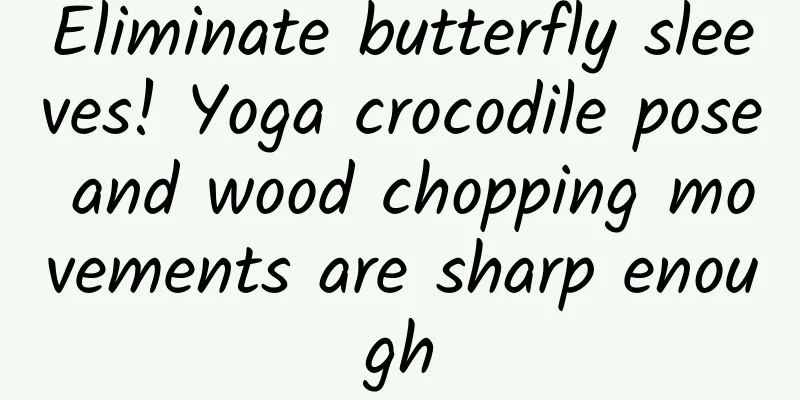Eliminate butterfly sleeves! Yoga crocodile pose and wood chopping movements are sharp enough

|
The fat butterfly sleeves are exposed as soon as you wave your hand, and there is no way to hide them. Yoga experts say that getting rid of those annoying fat patches is actually not that difficult! As long as you practice yoga chopping exercises, shoulder twists, half planks, crocodile poses, and corpse poses moderately to exercise the triceps in your upper arms that are rarely used, it is a good way to help tighten your arm curves! Butterfly sleeves on the torso? It turns out that the upper arm muscles are not exercised enough! Indian yoga master Sujit Kumar mentioned in his new book "Healthy Yoga for the Whole Family" that butterfly arms refer to the triceps on the upper arm of the human body. Due to the large muscle area and few opportunities for utilization, fat accumulates. However, does the human body really use the upper arm muscles so little? In fact, although the human body often needs to use the arms to grasp objects in daily life, such daily movements mostly only stretch the front and sides of the arms; and rarely move the back of the arms. Therefore, over time, it will naturally become looser and more prone to fat accumulation. Shake the meat like this! Do 5 yoga poses to tighten your arms If you want to get rid of those annoying arm fats, moderate exercise of your upper arm muscles is the only way to successfully sculpt your lines! For example, the following five sets of movements that combine a variety of yoga poses, including: chopping wood, shoulder twists, half plank, finger-locking crocodile, corpse pose, and other yoga moves, are a good way to help tighten loose arms: [Movement 1: Chopping Movement] 1. Sitting posture. Raise your hands above your head, bend your elbows, and interlock your fingers. Open your shoulders back and stretch your chest and abdomen upward. 2. Inhale, move your arms back with your elbows toward the ceiling, stretching your shoulders. 3. Straighten your arms upwards with your arms close to your ears. Interlace your fingers and imagine yourself holding an axe. 4. Exhale and chop forward with both hands. Practice 10 times while breathing in and out. [Action 2: Arm Twisting] 1. Sitting posture. Raise your arms by your sides to shoulder height, palms facing up. 2. Turn your palms over as you inhale and exhale. Inhale, turn your left palm up and your right palm down. 3. Exhale, with your left palm facing down and your right palm facing up. Twist your arms like you are wringing out a towel. Practice 10 times. Note: Keep your arms at shoulder height as you turn your palms over. During the exercise, only the arms and shoulders are twisted, while the rest of the body remains still. [Movement 3: Half Chaturanga] 1. Start in Cat Pose. Kneel on the ground with your palms on the ground, arms straight, knees on the ground, thighs straight. 2. Exhale, bend your elbows, and slowly press your body down toward the floor. Use your waist and abdomen to exert force, and feel that you are supporting the weight of your entire body with your hands, back, and shoulders. Keep your toes on the ground and tighten your thigh and waist muscles. Look forward and keep your head straight. After 5 breaths, relax and lie down in prone position. Practice 2 times. [Movement 4: Makrasana / interlock fingers] 1. Lie prone with your legs straight and together, forehead on the ground, and hands on both sides of the body. 2. Place your hands behind your back with your fingers clasped together. 3. Inhale, raise your arms, straighten your elbows, and open your shoulders back. 4. Raise your feet and head, and slightly lift your chin. Straighten your feet and feel your leg muscles tense. Push your chest up and shoulders back. Stay for 5 breaths. Exhale and relax back to prone position. [Movement 5: Shavasana] Finally, use this action as the ending action of the course. Savasana, also known as the "big rest," is the essential finishing pose at the end of every yoga class. Through the corpse pose, the body can be 100% relaxed, and because when the human body lies flat, the head and heart are at the same level, the blood circulation will be smoother than when standing. In addition, after practicing the asana, the heart rate accelerates, the breathing becomes deeper and more rapid, and the blood can more easily flow back to the heart, thereby promoting circulation throughout the body and achieving a detoxification effect. In addition, most asanas speed up our heartbeat and breathing, stimulating the body's sympathetic nervous system, while the corpse pose relaxes the body and allows the parasympathetic nervous system to function. Therefore, our body can achieve a balance between the positive and the negative. 1. Lie flat on your back with your hands on both sides of your body, about 15 cm apart, with your palms facing up. 2. Open your legs to a comfortable width. Keep your head in line with your spine, face up, and not tilted to either side. 3. Relax your whole body, adjust to the most comfortable posture, and then stop moving your body. Close your eyes, empty your mind, and feel the flow and rhythm of your breath in your body. Note: 1. If you feel discomfort in your head and neck, you can place a small pillow or a folded blanket behind your head. 2. During the exercise, please do not move your body. |
>>: Psoriasis is not "ringworm"! Get rid of "ringworm" with this one trick...
Recommend
How long can you wash your hair and take a bath after a medical abortion? You will know after reading this
You can take a bath and wash your hair about half...
What are the symptoms of uterine fibroids? Is menstrual abnormality also a manifestation of uterine fibroids?
Uterine fibroids are one of the most common benig...
What to do if your breasts hurt during irregular menstruation
Common causes of irregular menstruation and breas...
How to effectively reduce body fat?
When losing weight, you can’t just look at the nu...
What to eat for abnormal leucorrhea
Abnormal leucorrhea can be improved by adjusting ...
Why haven't I had my period for two months?
Missing your period for two months may be due to ...
What are the symptoms of irregular menstruation? What are the treatments for irregular menstruation?
Menstruation is a good friend that every woman ha...
Can uterine fibroids be treated with minimally invasive surgery if they are too large?
Can minimally invasive surgery be performed if ut...
How much does it cost to check for cervical warts?
After being infected with cervical warts, many pa...
Is 30mm of pelvic effusion serious?
Is pelvic effusion of 30mm considered serious? 1....
How much do you know about the symptoms of female adnexitis?
What are the symptoms of adnexitis? Understanding...
What are the symptoms of cervical hypertrophy?
Cervical hypertrophy is actually a type of chroni...
What are the common causes of dysmenorrhea?
Dysmenorrhea is a physiological phenomenon that w...
How to treat unmarried women with uterine fibroids? How to treat unmarried women with uterine fibroids?
Uterine fibroids are a very common gynecological ...
Postpartum mothers complain: I can’t regain my weight? Doctors reveal: 5 major reasons why it’s hard to lose weight after childbirth
Many women always complain that "the weight ...









